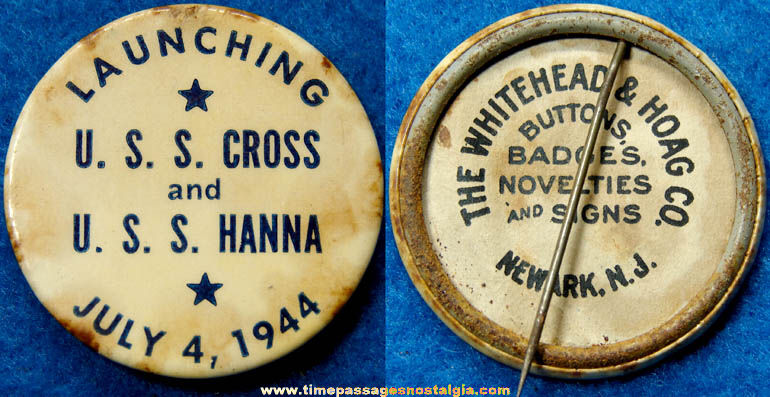
   | | | Any group of items being offered as a lot must be sold as a lot. | | Whether you've collected Memorabilia for years or just want to feel like a kid again, please take a few moments to browse through what we
have available for sale. | Nostalgic Memorabilia, Pop Culture Artifacts, Historic Items,
and "Shoe Box Toys" | | We have an extensive inventory that is not yet on our web site. If there is something you are looking for and did not find, please send us your wish list. | Quality Packing And
Postal Insurance | Great memories
make great gifts! | You don't have to be an eight year old to enjoy having
a childhood treasure. | | Worldwide Sales | | Unique & Fun Nostalgic Items |
| | | | The picture shows a front and back view of this 1944 U.S.S. Cross & U.S.S. Hanna Ship Launching Pin Back Button. This launching badge is believed to have been saved by a shipyard worker. It was found in a Staten Island, New York attic with many others dating from 1941 to 1944 when many ships were launched to do battle in World War II. They had been hidden away in that attic from the 1940s until 2008. The ship was launched from The Federal Shipbuilding & Dry Dock of Kearny, New Jersey. This pinback button is imprinted in black on a white background. There is a paper insert in the back. It is marked on the two sides as follows: U.S.S. CROSS
AND
U.S.S. HANNA
LAUNCHING
JULY 4, 1944 THE WHITEHEAD & HOAG CO.
NEWARK, N.J.
BUTTONS, BADGES, NOVELTIES AND SIGNS The pin back button measures 1-1/2'' wide. It is in poor to fair condition with spotting and surface rusting on the back as pictured. Below here, for reference, is some information on the U.S.S. Cross and U.S.S. Hanna: U.S.S. Cross (DE-448)
From Wikipedia, the free encyclopedia Career (US) Laid down: 19 March 1944
Launched: 4 July 1944
Commissioned: 8 January 1945
Decommissioned: 14 June 1946
In service: 1st Naval District, 6 June 1951
Out of service: 2 January 1958
Struck: 1 July 1966
Fate: sold for scrap 5 March 1968 General characteristics Displacement: 1,350/1,745 tons
Length: 306 ft. (93 m) overall
Beam: 36 ft. 10 in. (11.2 m)
Draft: 13 ft. 4 in. (4.1 m) maximum
Propulsion: 2 boilers, 2 geared turbine engines, 12,000 shp, 2 screws
Speed: 24 knots (44 km/h)
Range: 6,000 nm at 12 knots (22 km/h)
Complement: 14 officers, 201 enlisted
Armament: 2 - 5''/38, 4 - 40 mm AA, 10 - 20 mm AA, 3 - 21'' torpedo tubes, 1 Hedgehog, 8 depth charge projectors, 2 depth charge tracks. The U.S.S. Cross (DE-448) was a John C. Butler class destroyer escort acquired by the U.S. Navy during World War II. The primary purpose of the destroyer escort was to escort and protect ships in convoy, in addition to other tasks as assigned, such as patrol or radar picket. Post war she proudly returned home with one battle star to her credit. Cross (DE-448) was named in honor of Frederick Cushing Cross, Jr. who was awarded the Navy Cross for his attack on an enemy submarine and, mortally wounded, getting his plane and crew back to safety. Cross was 1aunched 4 July 1944 by Federal Shipbuilding and Dry Dock Co., Kearny, New Jersey; sponsored by Mrs. D. F. Cross, mother of the late Lieutenant (junior grade) Cross, U.S.N.R.; and commissioned 8 January 1945, Lieutenant H. L. Minshall, Jr., U.S.N.R., in command. World War II Pacific Theatre operations
Departing New York 22 March 1945, Cross called at San Diego, California, before arriving at Pearl Harbor for additional training. She sailed on 8 May escorting a convoy for Ulithi, and from 29 May to 11 September Cross continued to escort vital supply laden convoys from Ulithi to Okinawa. After repairs at Okinawa, she called at San Diego and Boston, Massachusetts, then put in to Green Cove Springs, Florida, where she was placed out of commission in reserve 14 June 1946. Recommissioned as a training ship
Recommissioned 6 June 1951, Cross was assigned to the 1st Naval District to serve as a training ship for New England Naval Reservists. She remained in this employment until placed in reserve again 2 January 1958. She was struck from the Navy list on 1 July 1966, and, on 5 March 1968, she was sold for scrap. Cross was awarded one battle star for World War II service.
****************************************
U.S.S. Hanna (DE-449)
From Wikipedia, the free encyclopedia Career (US) Laid down: 23 March 1944
Launched: 4 July 1944
Commissioned: 27 January 1945
Decommissioned: 31 May 1946
In service: NRT, 11th Naval District, 26 November 1957
Out of service: 11 December 1959
Struck: 1 December 1972
Fate: sold for scrap 3 December 1973 General characteristics Displacement: 1,350/1,745 tons
Length: 306 ft. (93 m) overall
Beam: 36 ft. 10 in. (11.2 m)
Draught: 13 ft. 4 in. (4.1 m) maximum
Propulsion: 2 boilers, 2 geared turbine engines, 12,000 shp, 2 screws
Speed: 24 knots (44 km/h)
Range: 6,000 nm at 12 knots (22 km/h)
Complement: 14 officers, 201 enlisted
Armament: 2 - 5''/38, 4 - 40 mm AA, 10 - 20 mm AA, 3 - 21'' torpedo tubes, 1 Hedgehog, 8 depth charge projectors, 2 depth charge tracks. The U.S.S. Hanna (DE-449) was a John C. Butler class destroyer escort acquired by the U.S. Navy during World War II. The primary purpose of the destroyer escort was to escort and protect ships in convoy, in addition to other tasks as assigned, such as patrol or radar picket. She proudly returned home with five battle stars to her credit after she was reactivated for Korean War duty. Hanna (DE-449) was named in honor of William T. Hanna who was killed in action 9 October 1942 while attached to the 1st Marine Division Reinforced on Guadalcanal. He was awarded the Navy Cross posthumously. She was launched 4 July 1944 by the Federal Shipbuilding & Drydock Co., Kearny, New Jersey; sponsored by Mrs. William P. Hanna, mother; and commissioned 27 January 1945, Lt. Comdr. Means Johnston, Jr., in command. World War II Pacific Theatre operations
After shakedown out of Bermuda and Guantanamo Bay, Hanna returned to New York 24 March 1945. Departing New York 9 April she escorted Akutan (AB-13) to Cristobal, Panama Canal Zone, then sailed via San Diego, California, arriving Pearl Harbor 4 May. After more intensive training and various escort missions in Hawaiian waters Hanna sailed 9 June for Eniwetok where she took up duty with Marshall Gilberts Surface Patrol and Escort Group. This duty continued until 28 September after the Japanese surrender. End of war activity
Then she and the U.S. prize Tachibana Maru formed the task unit to evacuate Japanese soldiers and sailors from Wake Island. Embarking 700 passengers they reached Tokyo 12 October. The U.S. Navy prize crew was withdrawn; the United States ensign hauled down; and Tachibana Maru turned over to the Japanese. Departing Tokyo 24 October 1945 Hanna returned to Eniwetok and then sailed to Guam, where she took up duty as air sea rescue and weather reporting ship. She continued this important task until her return to the States, where she decommissioned at San Diego, California, 31 May 1946 and joined the Pacific Reserve Fleet. Recommissioned during the Korean crisis
Hanna recommissioned at San Diego 27 December 1950, Lt. Comdr. C. W. Ward in command to augment Navy strength in the Korean conflict. Once more an active unit of the U.S. Pacific Fleet, Hanna served with Escort Squadron 9 until 16 April 1951 when she sailed for the Western Pacific. Here she served as patrol ship in the Formosa Straits. In June 1951 Hanna joined Task Force 95 for blockading and escort duties off the west coast of Korea. In August, while on shore bombardment mission in Wonsan Harbor Hanna was instrumental in silencing enemy shore batteries after a duel lasting more than 2 hours. During the ensuing months Hanna served gallantly, operating with the Blockading and Escort Forces of Task Force 95. She was part of the antisubmarine and antiaircraft screen for our aircraft carriers launching repeated strikes against the Communists. In early November 1951 Hanna was detached for the United States, reaching San Diego 26 November for overhaul. Three months later Hanna returned to the western Pacific and resumed her shore bombardment missions in addition to escorting damaged vessels and investigation of fishing craft. She returned to San Diego 9 June 1953. After operations off the California coast Hanna departed 19 November for an island hopping cruise of the Central Pacific, returning to San Diego 6 June 1954. Continued Pacific Ocean deployments
Between 9 November 1954 and 28 July 1957 Hanna made three more deployments to the western Pacific. On her last deployment Hanna took up patrolling the Central Carolines, Northern Marianas, the Bonins, and the Volcano Islands. In addition she participated in a rescue mission involving the Chinese Nationalist merchantman S.S. Ping Tung that had run aground on Yokoate Shima, an island of the Ryukyu chain. Assigned training ship duties
Hanna's home port was changed to Long Beach, California, 26 November 1957 and she was designated a Naval Reserve Training Ship. She commenced the first of her reserve training cruises 6 February 1958 to Manzanillo, Mexico, and from that date until 27 August 1959 made 18 such cruises in addition to numerous weekend cruises. Final decommissioning
Hanna decommissioned at Mare Island 11 December 1959 and joined the Pacific Reserve Fleet. Hanna received five battle stars for Korean service. |
|
Click on image to zoom.
 |